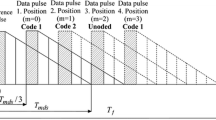Abstract
Based on the research on time domain and frequency domain transmitted reference Impulse Radio Ultra-WideBand (IR-UWB) system, this paper studies the optimization design for code domain transmitted reference IR-UWB system, and proposes a modified code domain transmitted reference IR-UWB system. The Bit Error Rate (BER) expressions for the modified system model in the condition of Additive White Gaussian Noise (AWGN) and multipath fading are deduced respectively. In addition, the performances of the modified system and the other three transmitted reference IR-UWB systems are simulated and compared. Theoretical analysis and simulation results show that the performance of the modified system is superior to the other three systems.
Similar content being viewed by others
References
R. Hoctor and H. Tomlinson. Delay-hopped transmitted-reference RF communications. IEEE Conference on Ultra-Wideband Systems and technologies, Wyndham Baltimore Inner Harbor, USA, May 2002, 265–270.
D. L. Goeckel and Q. Zhang. Slightly frequency-shifted reference Ultra-Wideband (UWB) radio: TR-UWB without the delay element. IEEE Military Communications Conference, Atlantic City, NJ, USA, Oct. 2005, 1–7.
J. Zhang, H. Y. Hu, L. K. Liu, et al.. Code-orthogonalized transmitted-reference Ultra-Wideband (UWB) wireless communication system. International Conference on Wireless Communications, Networking and Mobile Computing, Shanghai, China, Sept. 2007, 528–532.
R. Hoctor and H. Tomlinson. An overview of delay-hopped, transmitted-reference RF communications. GE Research & Development Center, Fairfield, Jan. 2002.
J. D. Choi and W. E. Stark. Performance of ultra-wideband communications with suboptimal receivers in multipath channels. IEEE Journal on Selected Areas in Communications, 20(2002)9, 1754–1766.
H. Zhang and D. L. Goeckel. Generalized transmitted-reference UWB systems. IEEE Conference on Ultra-Wideband Systems and Technologies, Virginia, USA, Nov. 2003, 147–151.
Y. L. Chao and R. A. Scholtz. Optimal and suboptimal receivers for ultra-wideband transmitted reference systems. IEEE Global Telecommunications Conference, San Francisco, USA, Dec. 2003, 2:759–763.
S. Gezici, F. Tufvesson, and F. Molisch. On the performance of transmitted-reference impulse radio. IEEE Global Telecommunications Conference, Dallas, TX, USA, Nov. 2004, 5: 2874–2879.
S. Zhao, H. Liu, and Z. Tian. A decision feedback autocorrelation receiver for pulsed ultra-wideband systems. IEEE Radio and Wireless Conference, Atlanta, USA, Sept. 2004, 251–254.
S. Franz and U. Mitra. Integration interval optimization and performance analysis for UWB transmitted reference systems. International Workshop on Ultra Wideband Systems Joint with Conference on Ultrawideband Systems and Technologies (Joint UWBST & IWUWBS), Kyoto, Japan, May 2004, 26–30.
T. Q. S. Quek and M. Z. Win. Analysis of UWB transmitted-reference communication systems in dense multipath channels. IEEE Journal on Selected Areas in Communications, 23(2005)9, 1863–1874.
W. M. Gifford and M. Z. Win. On transmitted-reference UWB communications. The 38th Asilomar Conference on Signals, Systems, and Computers, Cambridge, MA, USA, Nov. 2004, 2: 1526–1531.
Q. Zhang and D. L. Goeckel. Multi-differential slightly frequency-shifted reference Ultra-Wideband (UWB) radio. The 40th Conference on Information Sciences and Systems, Princeton, New Jersey, USA, Mar. 2006, 615–620.
D. L. Goeckel and Q. Zhang. Slightly frequency-shifted reference Ultra-Wideband (UWB) radio. IEEE Transactions on Communications, 55(2007)3, 508–519.
Q. Zhang, D. L. Goeckel, J. Burkhart, et al.. FSR-UWB (TR-UWB without the delay element): Effect of impulse dithering and experimental results. IEEE International Conference on Ultra-wideband, Waltham, MA, USA, Sept. 2006, 315–320.
J. Zhang, H. Y. Hu, and Z. Y. Zhang. Time acquisition for code-orthogonalized transmitted-reference Ultra-Wideband (UWB) wireless communication system. IEEE International Workshop on Radio-Frequency Integration Technology, Singapore, Dec. 2007, 50–53.
A. A. D’Amico and U. Mengali. Code-multiplexed UWB transmitted-reference radio. IEEE Transactions on Communications, 56(2008)12, 2125–2132.
S. Gezici. Coded-reference ultra-wideband systems. IEEE International Conference on Ultra-Wideband, Hannover, Germany, Sept. 2008, 3: 117–120.
H. Nie and Z. Z. Chen. Code-shifted reference Ultra-Wideband (UWB) radio. The 6th Communication Networks and Services Research Conference, Halifax, Nova Scotia, Canada, May 2008, 385–389.
H. Nie, and Z. Z. Chen. Differential code-shifted reference Ultra-Wideband (UWB) radio. IEEE 68th Vehicular Technology Conference, Calgary, Canada, Sept. 2008, 1–5.
Author information
Authors and Affiliations
Corresponding author
Additional information
Supported by the National High Technology Research and Development Program of China (863 Program) (No. 2009AA011205) and the Important National Science and Technology Specific Projects (No. 2009ZX03006-008).
Communication author: Li Xia, born in 1977, female, Ph.D. candidate, Engineer.
About this article
Cite this article
Li, X., Jiang, H., Zhang, J. et al. A modified code domain transmitted reference UWB system. J. Electron.(China) 28, 341–348 (2011). https://doi.org/10.1007/s11767-011-0572-2
Received:
Revised:
Published:
Issue Date:
DOI: https://doi.org/10.1007/s11767-011-0572-2




